Ski: 2021-2022 Nordica Santa Ana 104 Free, 172 cm
Test Locations: Mt. Crested Butte, Monarch Mountain, & Aspen Highlands, Colorado
Days Skied (total): ~30
Available Lengths: 158, 165, 172, 179 cm
Blister’s Measured Tip-to-Tail Length (straight-tape pull): 170.2 cm
Blister’s Measured Weight per Ski: 1792 & 1792 grams
Stated Dimensions: 134-104-123 mm
Blister’s Measured Dimensions: 134.8-103.4-125.2 mm
Stated Sidecut Radius (171 cm): 16.5 meters
Measured Tip & Tail Splay (ski decambered): 73 / 50 mm
Measured Traditional Camber Underfoot: 4.5 mm
Core: balsa/poplar/beech + titanal layer + carbon & fiberglass laminate
Base: sintered
Factory Recommended Mount Point: -8.5 cm from center / 76.6 cm from tail
Boots / Bindings: Atomic Hawx Ultra 110 W, Tecnica Cochise Pro W / Marker Griffon / MountainFLOWAll-Temp
Reviewers:
- Sascha Anastas: 5’1”, 100 lbs / 155 cm, 45.3 kg
- Kara Williard: 5’9”, 167 lbs / 175 cm, 75.7 kg
[Note: Our review was conducted on the 20/21 Santa Ana 104 Free, which returns unchanged for 21/22, apart from graphics.]

Intro
Sascha Anastas: It’s no secret here that many of us at Blister are big fans of Nordica’s Santa Ana line. Both Kristin Sinnott and Kara Williard raved about the previous iterations of the Santa Ana 100 and Santa Ana 110, and they’re both pretty psyched on the recently revised versions of the Santa Ana 93 and 98.
While I had enjoyed some of the older Santa Ana skis, I ultimately found them to be a bit on the heavy / sluggish side, particularly for someone of my size. So I was pretty excited to hear that the 20/21 Santa Ana line was getting a bit lighter and reportedly being designed to be more accessible to a broader range of skiers. Even better news was that Nordica was adding a 104mm-width ski, which I would say is my sweet spot for an all-mountain, everyday resort ski.
I was able to spend around 15 days on the new Santa Ana 104 Free (which returns unchanged for 21/22) in lots of different terrain and a variety of snow conditions, so it’s now time to discuss this new ski from Nordica.
Kara Williard: For several reasons, I was really excited when Sascha handed off the 172 cm Santa Ana 104 Free. First, I have spent around five days on the men’s 179 cm Enforcer 104 Free and was really impressed by it, but it also felt pretty heavy and burly, so I wanted to compare it against the lighter construction of the Santa Ana. Second, I thought it would be awesome to test it against my 18/19 Santa Ana 110 that often serves as my powder ski, to get an idea of how the latest Santa Ana construction compares to the previous version. I also loved and previously reviewed the 19/20 Santa Ana 100, and was curious to see where the Santa Ana 104 Free falls between the two. Lastly, Sascha is a super strong skier, but with the substantial weight difference between us, I wanted to add some additional thoughts and perspectives. I’ve now spent many days on the Santa Ana 104 Free and have added my thoughts throughout this review.
What Nordica says about the Santa Ana 104 Free
“When the snow falls, amplify your day with the Santa Ana 104 Free. Slightly narrower than the Santa Ana 110 Free, it’s the perfect daily driver for those who love to freeski off-piste and play on the trail. This new addition to the legendary Santa Ana collection is already renowned for providing a smooth and playful attitude in a design that’s accessible and easy to ski. And while the Santa Ana 104 Free craves softer snow, it offers exceptional performance—and plenty of fun—no matter the terrain or conditions. To minimize weight and boost stability and response, it pairs a wood core with carbon and a sheet of terrain-specific metal. This also dampens vibrations for an especially smooth ride. Stable and playful, the Santa Ana 104 Free helps you discover your potential—and everything the mountain has to offer.”
Shape & Rocker Profile
The Santa Ana 104 Free looks pretty similar overall to the other skis in the Santa Ana lineup. Its shape is fairly typical for a 104mm-wide ski, with slightly less tapered tips and tails than something like the DPS Zelda A106, Prior Flute, and K2 Mindbender 106C.
One of the big areas where the Santa Ana 104 Free differs from the narrower, non-Free Santa Ana skis is its rocker profile. Compared to the Santa Ana 88, 93, and 98, the Santa Ana 104 Free has significantly more tail rocker and a more twinned tail. The idea is that the wider 104 Free and 110 Free are meant to be a bit more playful than their narrower counterparts.
Flex Pattern
Here’s how we’d describe the flex pattern of the Santa Ana 104 Free:
Tips: 6
Shovels: 6.5-7
In Front of Toe Piece: 8-9
Underfoot: 9.5
Behind the Heel Piece: 9.5-8.5
Tails: 8-7
The Santa Ana 104 Free’s flex pattern feels very similar to the other Santa Ana skis, with moderately soft tips, a strong flex through the middle of the ski, and a tail that’s a bit stiffer than the tips.
Weight
While the older Santa Ana skis were fairly heavy, the Santa Ana 104 is nothing particularly out of the ordinary when it comes to weight. Our pair of the 172 cm length came in at 1792 grams per ski, which is in line with several other skis in its class. It’s also worth noting that the Santa Ana 104 Free is notably lighter than the Santa Ana 93 and 98.
For reference, here are a number of our measured weights (per ski in grams) for some notable skis. Keep in mind the length differences to try to keep things apples-to-apples.
1592 & 1637 Head Kore 97 W, 170 cm (21/22)
1626 & 1645 Line Pandora 104, 165 cm (18/19–21/22)
1687 & 1695 Elan Ripstick 102 W, 170 cm (20/21–21/22)
1693 & 1710 Moment Sierra, 172 cm (21/22)
1639 & 1717 Head Kore 103 W, 171 cm (21/22)
1706 & 1784 Liberty Genesis 106, 171 cm (19/20–20/21)
1709 & 1710 Blizzard Sheeva 10, 172 cm (17/18–21/22)
1711 & 1772 DPS Alchemist Zelda 106 C2, 171 cm (19/20–20/21)
1735 & 1740 K2 Mindbender 106C, 175 cm (19/20–21/22)
1762 & 1801 K2 Mindbender 98Ti Alliance, 168 cm (19/20–21/22)
1792 & 1792 Nordica Santa Ana 104 Free, 172 cm (20/21–21/22)
1797 & 1839 Rossignol BLACKOPS Rallybird, 170 cm (20/21–21/22)
1831 & 1852 Rossignol BLACKOPS Rallybird Ti, 171 cm (20/21–21/22)
1881 & 1895 Salomon QST Lumen 99, 174 cm (19/20–21/22)
1903 & 1917 Nordica Santa Ana 93, 172 cm (20/21–21/22)
1917 & 1935 Nordica Santa Ana 98, 172 cm (20/21–21/22)
1941 & 1948 Salomon QST Stella 106, 174 cm (19/20–21/22)
1955 & 1990 Coalition Snow SOS, 173 cm (19/20–21/22)
1969 & 1988 4FRNT MSP CC, 171 cm (20/21–21/22)
1983 & 1999 Nordica Santa Ana 100, 177 cm (18/19–19/20)
2015 & 2024 Blizzard Black Pearl 97, 171 cm (20/21–21/22)
2076 & 2078 Nordica Santa Ana 110, 177 cm (18/19–19/20)
2104 & 2115 Volkl Secret 102, 170 cm (19/20–21/22)
Alright, now onto how the ski actually performs on snow:
FULL REVIEW
Powder
Sascha Anastas (5’1”, 100 lbs / 155 cm, 45.3 kg): At 104 mm underfoot — not particularly wide for a pure pow ski — the Santa Ana 104 performs fairly well in fresh snow. I did not get to log a lot of powder days on this ski, but I was fortunate to catch the tail end of a storm at Monarch Mountain and found pockets of heavy / wet powder at least 15 in / 38 cm deep.
Surprisingly, the Santa Ana 104 was not as surfy / loose as I thought it would be, given its rockered tips and tails. To get it to slash sideways, I had to keep my weight more forward and put more pressure on the front of my boot, especially in the middle of my turns. When transitioning to my next turn, I had to quickly transition my weight back to unload the shovels to avoid burrowing the tips (though, again, this was pretty deep, heavy snow).
The result was that I found myself skiing faster on the Santa Ana 104 Free than I would on something a bit softer and lighter, like the Line Pandora 104, which feels more inclined to slash and surf through pow with more turns. I would be curious to see how the new Santa Ana 110 Free compares in terms of flotation and maneuverability in deep snow, but for the Santa Ana 104, I think it best suits those who like to ski fast in pow, rather than make lots of short, slashed turns.
Kara Williard (5’9”, 167 lbs / 175 cm, 75.7 kg): I have been fortunate to ski some unconsolidated early season powder on the Santa Ana 104 before and during the massive late-December storm system, and while it isn’t the absolute quickest or easiest ski to slash, similar to what Sascha mentioned above, it does perform admirably for its width in terms of flotation.
In pretty much all terrain and conditions, the Santa Ana 104 performs better when the skier is in a forward position and working to bend the ski (and getting the tails to release as a result). It doesn’t feel like the most playful ski when it comes to quick, slashy turns, but rather, the Santa Ana 104 feels better and smoother at speed. When attempting to warm up the legs on early season pow, I found myself having to focus on commanding the ski and working the turns, but it still floated and surfed atop the snow without feeling too heavy or sluggish. Where the ski feels like it’s thriving is as the snow gets skied out and choppy or there’s some inconsistent snow texture, where the Santa Ana 104’s suspension shines, leading to an overall smooth ride.
I find the Santa Ana 104’s tail pretty easy to release, and it also provides an energy and liveliness that makes skiing soft snow pretty rewarding when popping in and out of turns. It serves as an overall better option in powder than most of the narrower skis I have been testing it against, such as the Volkl Secret 96 and 4FRNT MSP CC. Most comparable to the Santa Ana in terms of floatation is the Blizzard Sheeva 10 and the Head Kore 103 W, though the Kore 103 W is a lot stiffer throughout, so the Santa Ana 104 Free feels significantly more playful, whereas the Sheeva 10 is even more maneuverable, forgiving, and playful than both.
Soft Chop
Sascha: Soft chop is where this ski is most at home. The Santa Ana 104 can charge through this snow unlike most other skis I have reviewed. While skis in this same width category, like the Line Pandora 104 and the Rossignol Soul 7 HD W (104 mm underfoot), tend to float on the top of the soft chop, the Santa Ana Free 104 charged powerfully through the softer patches of pushed-around snow. I definitely found myself being able to ski much faster in soft chop on the Santa Ana 104 Free than I could on something lighter like the Pandora 104.
When I encountered patches of thicker, untouched, heavy powder between the more skied-off patches, the Santa Ana 104 did not get bogged down and made it easy to maintain speed (and at times, almost too easy). While I do prefer a ski that’s stable in soft chop, it did take some getting used to skiing chop at the higher speeds the Santa Ana 104 Free encouraged. While it’s quite stable at higher speeds compared to other women’s skis, the Santa Ana 104 is not the most forgiving — to stay in control, I had to aggressively stay forward in my boots and balanced on the ski.
So those with good technique will likely enjoy how hard they can ski the Santa Ana 104 Free in soft, choppy conditions, but those looking to take it easy have better options.
Kara: While I haven’t skied the Santa Ana 104 in a ton of soft chop, I skied it quite a bit in spring slush, and I would argue there is some carryover here. As the snow softened up and got pretty heavy, the Santa Ana 104 felt substantial enough to charge and remain stable, but also felt lively enough to play around on and pop from turn to turn. It offered enough surface area to avoid feeling bogged down, while its smooth and stable ride felt consistent and composed when I got it up to speed, which was always the feeling I was most impressed with in previous iterations of the Santa Ana series.
Through some variable conditions that were generally pretty soft, I was pleased with the Santa Ana 104’s combination of both stability at higher speeds and an ability to slow it down and transition into shorter turns. This was in contrast to the feeling of the Head Kore 103 W, which feels a lot lighter when making quick turns, but its low weight also translates to a lot of feedback when charging through the chop, with notably poorer suspension than the Santa Ana 104.
The 172 cm Santa Ana 104 is slightly on the shorter end of what I typically ski (though I’ve spent a lot of time on many ~170-172 cm skis), and to me, it felt like a pretty maneuverable ski. There are some heavier and/or stiffer skis I’ve used that feel a little more composed at high speeds in variable conditions, with the 170 cm Volkl Secret 96 and 172 cm 4FRNT MSP CC being the main ones that come to mind. But (as will be a theme here) I think the Santa Ana 104 Free offers a very appealing combo of maneuverability and stability that makes it stand out from the heavier, less rockered skis in this class.
Firm Chop / Crud
Sascha: Firm and set-up crud was not a big problem for the Santa Ana 104, especially compared to the numerous lighter skis in this class.
In bulletproof, refrozen snow, it didn’t get thrown around much so long as I had enough power and speed to stay balanced on top of the ski. As in other conditions, the Santa Ana 104 wanted to go fast in crud and I often found myself either slashing it sideways to shed speed, or get as forward as I could and enjoy the ride, while the ski blasted over the crud. I think those who like to make lots of smaller turns in challenging, cruddy conditions would prefer a less demanding ski, such as the Blizzard Sheeva 10. Personally, for really firm chop, I tend to prefer a narrower ski that easier when it comes to making jump turns around the set-up, hard snow, like the Liberty Genesis 96. But provided that you stay on top of it, the Santa Ana 104 offers impressive stability in non-ideal conditions.
Kara: Similar to softer variable conditions, the Santa Ana 104 offers a smooth and supportive ride that both allows me to make quick and playful turns, while also feeling heavy and damp enough to avoid feeling like I was getting bounced around by the ski / snow. On some really rough mornings of spring refreeze, I was pleased that the ski initiated turns with ease, but then remained stiff and smooth throughout, while on edge. While its shovel and tail are a bit more rockered than previous iterations of the Santa Ana 100, it doesn’t feel chattery or too loose in unforgiving crud. The tail also feels supportive, without feeling excessively locked in or stiff (to me), so even if I was thrown off balance I could still turn from the tails and not feel punished by the back half of the ski. This is contrasted with the Blizzard Black Pearl 97, which definitely requires more precise technique to avoid feeling like you’re getting bucked by its stiff tails.
I would agree that the Santa Ana 104 prefers a skier that will stay on top of it and in a forward, pressured stance, but it feels more forgiving than the Volkl Secret series, the Blizzard Black Pearl 97, as well as the 19/20 Santa Ana 100 and 110.
In terms of suspension, stability, and smoothness in chop, I’d say the closest ski I’ve used is the 180 cm Blizzard Sheeva 10. The 177 cm Head Kore 103 W feels a lot lighter in crud and is definitely not as stable or planted.
Groomers
Sascha: For its width, the Santa Ana 104 is pretty easy to get on edge and, to me, feels happiest at higher speeds. It seemed to prefer larger and faster turns down the fall line, rather than shorter, quicker, snappier ones.
Loading the 172 cm Santa Ana 104 mid-turn to make dynamic and energetic transitions required a lot of power for me — sometimes more power than I had to offer. While I used to ski race, I’m only 5’1” / 155 cm, so larger skiers might find the 172 cm Santa Ana 104 easier to bend on piste.
Nonetheless, it was easy to maintain the ski on edge throughout the turn. On occasion, when I was a bit off-balance or had too much weight on my uphill ski, the tips of the Santa Ana 104 felt a little catchy (one instance resulted in a pretty spectacular groomer crash). But for a 104mm-wide ski with a notable amount of tip and tail rocker, the Santa Ana 104 performs pretty well on piste. Ultimately, I found that the shorter, lighter, and softer 165 cm Line Pandora 104 was more intuitive on groomers and easier for me to load — but certainly was not as stable as this Santa Ana 104.
Kara: For a ski that’s 104 mm underfoot, the Santa Ana 104 is really fun to carve. On piste, I did not experience the instability from the shovel that I sometimes felt on firm moguls (see below). As in other conditions, on groomers, the Santa Ana 104 feels like a damp and responsive ski that’s stable on edge. It reminded me of my experience carving the old Santa Ana 100, with just a little bit easier initiation.
I did find the 172 cm Santa Ana 104 easy to initiate and to bend on piste — considerably more so than the 179 cm Nordica Enforcer Free 104. There are definitely stiffer skis that require more energy to bend on piste, such as the Volkl Secret 96, Secret 102, and Blizzard Black Pearl 97, though all of those skis are more stable at higher speeds and inspire more confidence when tipping them up at more aggressive edge angles.
Moguls
On the 172 cm Santa Ana 104, it took a little getting used to when navigating a tight line in the troughs of medium to large moguls. The ski was not particularly intuitive to me, especially at first. I had to focus on driving its stiff-feeling tips when maneuvering through bumps, whereas the lighter, shorter 165 cm Pandora 104 made it easier to execute precise and quick turns without requiring me to transition my weight as far forward.
Again, the 172 cm length might have been a bit on the long side for me, but once I established a rhythm, the Santa Ana 104 became fairly playful and very enjoyable. And in smaller, more spaced-out moguls and on less steep terrain, the ski encouraged higher speeds and aggressive skiing. I’ll be curious to see what Kristin and Kara think, given that they typically ski longer skis than I do. (Though it’s worth noting that I really like the 172 cm Rossignol Soul 7 HD W and find it notably easier in tight terrain; that ski is very similar to the Santa Ana 104 in terms of weight, though it has a more forgiving flex pattern and more tapered tips and tails.) Anyway, for me, the Santa Ana 104 seems best suited to skiers who ski bumps with good technique and a pretty forward, aggressive stance.
Kara: To me, the 172 cm Santa Ana 104 Free feels like a fairly lively and energetic ski, and this is something I especially noticed in moguls, regardless of whether they were firm or soft. Overall, the 172 cm version felt relatively playful and easy to move around, when compared with heavier, stiffer skis I’ve been on like the 170 cm Blizzard Black Pearl 97, though the Santa Ana 104 also feels a little soft in the shovel on firm moguls (for my preferences). The 179 cm Enforcer 104 Free seems to reconcile this for me, since it feels notably stiffer overall, though that definitely comes at the cost of maneuverability. The 172 cm Santa Ana 104 did feel more forgiving and playful than the previous (pre-19/20) iterations of the Santa Ana 100 and 110, though I am used to skiing both in 177 cm.
I did feel the ski to be instantly intuitive in moguls, with a more forgiving feel than many of the skis I have been on lately, such as the 171 cm 4FRNT MSP CC, 170 cm Volkl Secret 96, 180 cm Blizzard Sheeva 10, as well as previous (longer) iterations of the Santa Ana series. I still agree with Sascha in that the Santa Ana 104 is a ski that skis best when you are driving it with a forward stance, and there are lots of easier skis out there. But I think it could be particularly appealing to those progressing skiers who are looking to get a more stable ski, but don’t want something super challenging to ski — or for very experienced skiers who just prefer a slightly quicker ski.
Trees/ Tight Terrain
Sascha: I was initially intimidated to take the Santa Ana 104 in tighter trees because of their hankering for high velocities and because the ski felt a little on the long side to me. But after a few runs, I found that I was able to keep fairly good control of my speed and ski through tight trees similarly to how I skied between moguls by shifting my weight to the rockered tips and then dynamically transitioning to the next turn. When all was said and done, I decided I would have preferred the shorter 165 cm length when skiing such tight terrain. But especially in trees that aren’t moguled-up (i.e., with fairly smooth snow), I think the Santa Ana 104 makes for a fairly maneuverable, stable ski.
Kara: My experience with this ski in tight trees and steeps was very similar to moguls. The Santa Ana 104 didn’t feel like an excessively heavy or burly ski, but it still provided a level of smoothness and suspension that was especially noticeable on firm snow — and that many lighter, softer skis lack.
Many qualities of the 172 cm Santa Ana 104 are reminiscent of my Blizzard Sheeva 10, though I am skiing that in the 180 cm length; I think the Santa Ana 104 is a bit more ski to maneuver in equivalent lengths. Overall, the Santa Ana 104 provides the experience that I want in tight terrain, feeling supportive and stable but still maneuverable. It’s substantially easier than the old 177 cm Santa Ana 100 and 110, but in tight terrain, it still offers plenty of stability and support.
Steeps
Sascha: Despite how demanding it could be in tight, moguled terrain, I was totally impressed by how well the Santa Ana 104 handled more open, steep terrain.
My first run on this ski, at the advice of other reviewers, I went right to Headwall at Mt. Crested Butte. Over the past few years and certainly during the Blister Summit, that’s become our main testing ground for relatively open, steep, sustained terrain. I immediately noticed that the Santa Ana 104 was very stable when making precarious turns across the fall line and I did not experience any tip chatter.
I found the Santa Ana 104 to be fairly easy to whip around, even though it’s not the lightest. In chalky steeps where there weren’t huge moguls and deep troughs, I found that I didn’t need to be as dynamic or aggressive to pivot the ski and get the tails to release, but it still held an edge when I needed it to.
Kara: On steep pitches that are fairly open, like Sascha, I found this ski to handle really well. From a weight and maneuverability perspective, I did not find Santa Ana 104 to feel overly difficult to hop around on, or make tight turns. It excelled most on steep, chalky terrain with grippy snow, where I really enjoyed its blend of playfulness / quickness and stability / suspension. There were times when I wished for a slightly stiffer shovel and/or more ski in front of me, as I mentioned about my experience in moguls. But the upside is that I found the Santa Ana 104 quick to initiate and rewarding when making quick, precise, and dynamic movements. Most of the skis that I prefer to ski steeps on, especially when conditions are firm, are a little narrower and less rockered (e.g., Volkl Secret 96), which feels like it holds a more reliable on edge when the steeps are in their firmest condition. But the Santa Ana 104 also feels notably quicker, more maneuverable, and more forgiving than the Secret 96, so it’s all about priorities.
Playfulness
Sascha: I would not consider the 172 cm Santa Ana 104 to be particularly playful, given its propensity for speed and its power requirement. Once I got used to the ski, I did find that it made skiing moderately tight trees and more open bumps feel somewhat playful in terms of the dynamic skiing style it encouraged. But for the most part, this ski certainly felt directional and oriented toward aggressive skiing. For those looking for a more playful ski that’s still pretty capable at high speeds, I would recommend checking out the Line Pandora 104, Blizzard Sheeva 10, or the Icelantic Nia that I was able to take some laps on at the Blister Summit. With that said, the Santa Ana 104 is definitely more playful and forgiving than something even heavier, stiffer, and with less rocker, such as the Volkl Secret 102. I’d also be curious to A/B test the 172 cm Santa Ana 104 against the 172 cm Santa Ana 98 to see how playful the 104 feels in that case, given that the 98 has less tail rocker and is heavier.
Kara: I found the Santa Ana 104 to be fairly playful in some regards, especially when skiing a slightly shorter length than I would have picked for myself. Particularly compared to the heavier, older Santa Ana series, I think Nordica did a good job of making the new, lighter skis feel quicker and easier to initiate and a bit more forgiving in the tip and tail without totally forsaking the smoothness and stability I liked about the older skis.
When it comes to how energetic and easy it is to bend, I’d say the Santa Ana 104 is similar to the Blizzard Sheeva 10 and K2 Mindbender 106C, and considerably more playful overall than the Volkl Secret 96, Blizzard Black Pearl 97, and Head Kore 103 W.
If I wanted to prioritize support and high-speed stability over plafyulness and maneuverability, I would definitely opt for the 179 cm Nordica Enforcer Free, which has more metal, more weight, and more length. To me, that ski does not feel particularly playful, especially in terms of how easy it is to flick around and bend into turns, but the upside is even better composure in challenging conditions and terrain.
Who’s It For?
Sascha: The 172 cm Santa Ana 104 strikes me as a powerful all-mountain ski that requires a bit of input to maximize its potential. Early in the season when my legs were not in top ski shape (due to laziness or less than average turn executions), the ski could be punishing. While I’m guessing that the 165 cm length would be more accessible for someone my size, I still think this ski is best suited for a strong, advanced to expert skier who’s not afraid of speed and who wants to ski hard in a variety of terrain. It requires a good bit of skier input, but this ski is quite versatile across most conditions you’d typically encounter at the resort.
The Santa Ana 104 is more manageable at moderate speeds than the Volkl Secret 102, so it could be a good choice for those who found skis like that to feel too demanding and one-dimensional, but I think those looking for a very playful, easy ski have better options.
Kara: I would agree that a strong, advanced skier will be the best contender for the Santa Ana 104. Even skiing a length that felt accessible and forgiving to me, it does still prefer a forward stance and someone who knows how to bend a ski. In this way, it delivers on being a powerful, energetic, and stable ski. While I do find it to be a bit more forgiving than the old Santa Ana 100 or 110, the 104 Free is still going to be best utilized by skiers who can work to access the energy and rebound of it. That said, I think there is still a window for upper intermediate-advanced skiers to enjoy it in a shorter length and still take advantage of its petty smooth and maneuverable ride. There are definitely skis that are more forgiving, softer, and a easier to progress on, as well as some others that are more demanding and more stable, but the Santa Ana 104 slots nicely in the middle (if not a bit closer to the more advanced end of the spectrum).
Bottom Line
Sascha: The 172 cm Nordica Santa Ana 104 Free had me skiing faster and harder than most skis I have tested in some time. It required a lot of power and liked to go fast no matter the terrain, which was nice when I was on my A-game but less ideal when I wasn’t staying on top of the ski and focusing on my technique.
Kara: For people who have liked previous iterations of the Nordica Santa Ana series, I believe you will get along well with the Santa Ana 104, while also benefiting from quicker initiation and slightly easier maneuverability.
If I were looking at a long-term selection for myself, I would probably gravitate toward the 179 cm version or the 179 cm Enforcer 104, just because I would take stability over playfulness, particularly on really firm snow. But the Enforcer 104 is noticeably heavier and definitely requires more input to feel like it’s coming alive.
When it comes to handling various conditions and terrain, I think the Santa Ana 104 is a very versatile ski and a solid potential 1-ski quiver for certain skiers. In fact, it was my pick for a one-ski quiver in our recent ski quiver selections.
Overall, I think Nordica has done a good job of making the Santa Ana 104 more maneuverable and accessible than its predecessors, without losing all of the damp and stable ride that many people (myself included) appreciated about the older Santa Anas. If you don’t need the absolute stiffest or more stable ski out there, nor some super light, soft ski that falls apart when conditions aren’t ideal, it’s worth a close look.

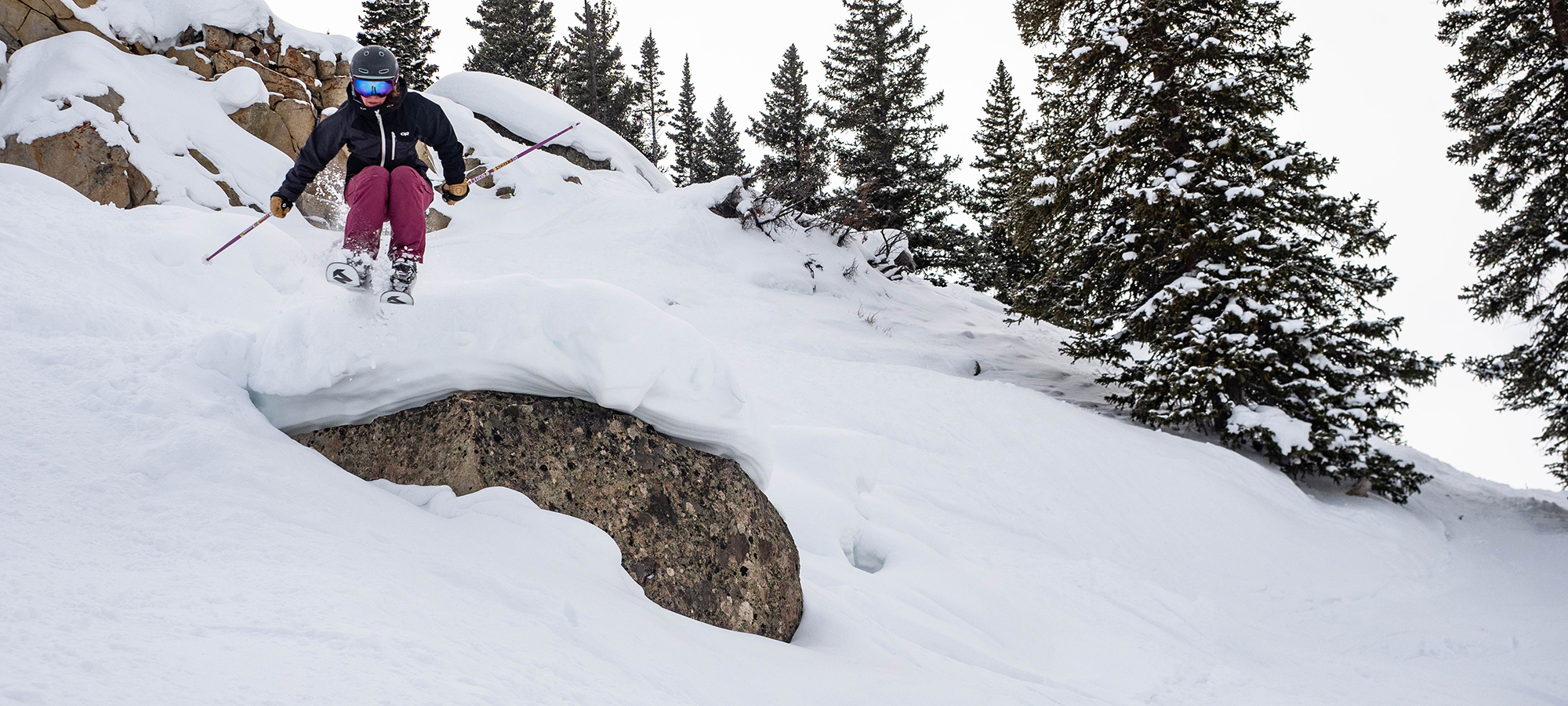

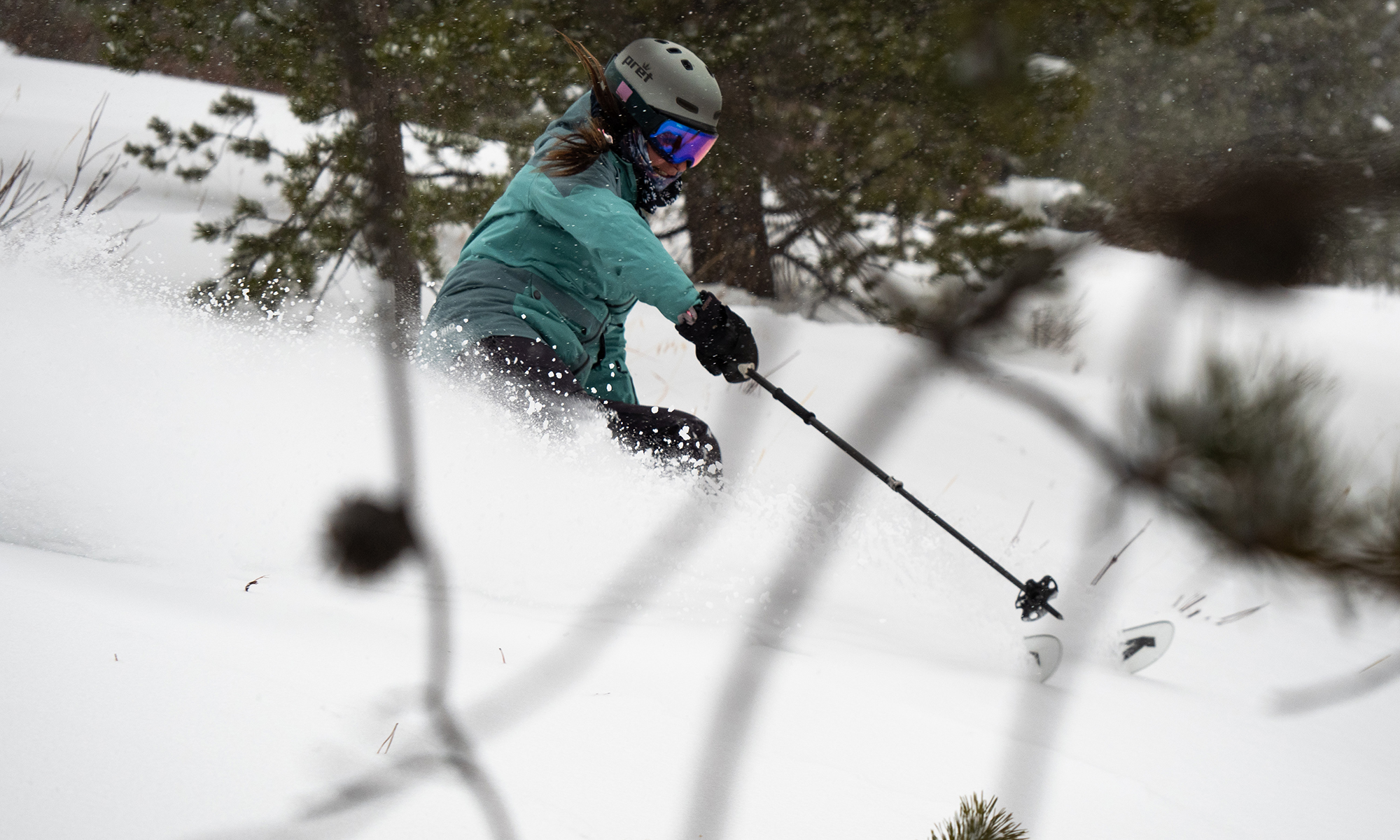
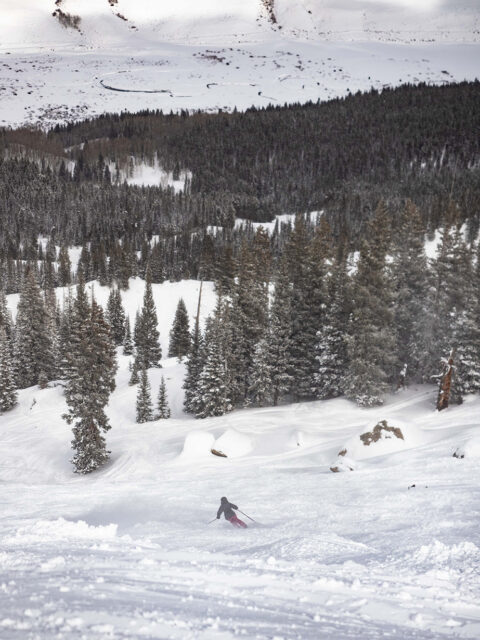
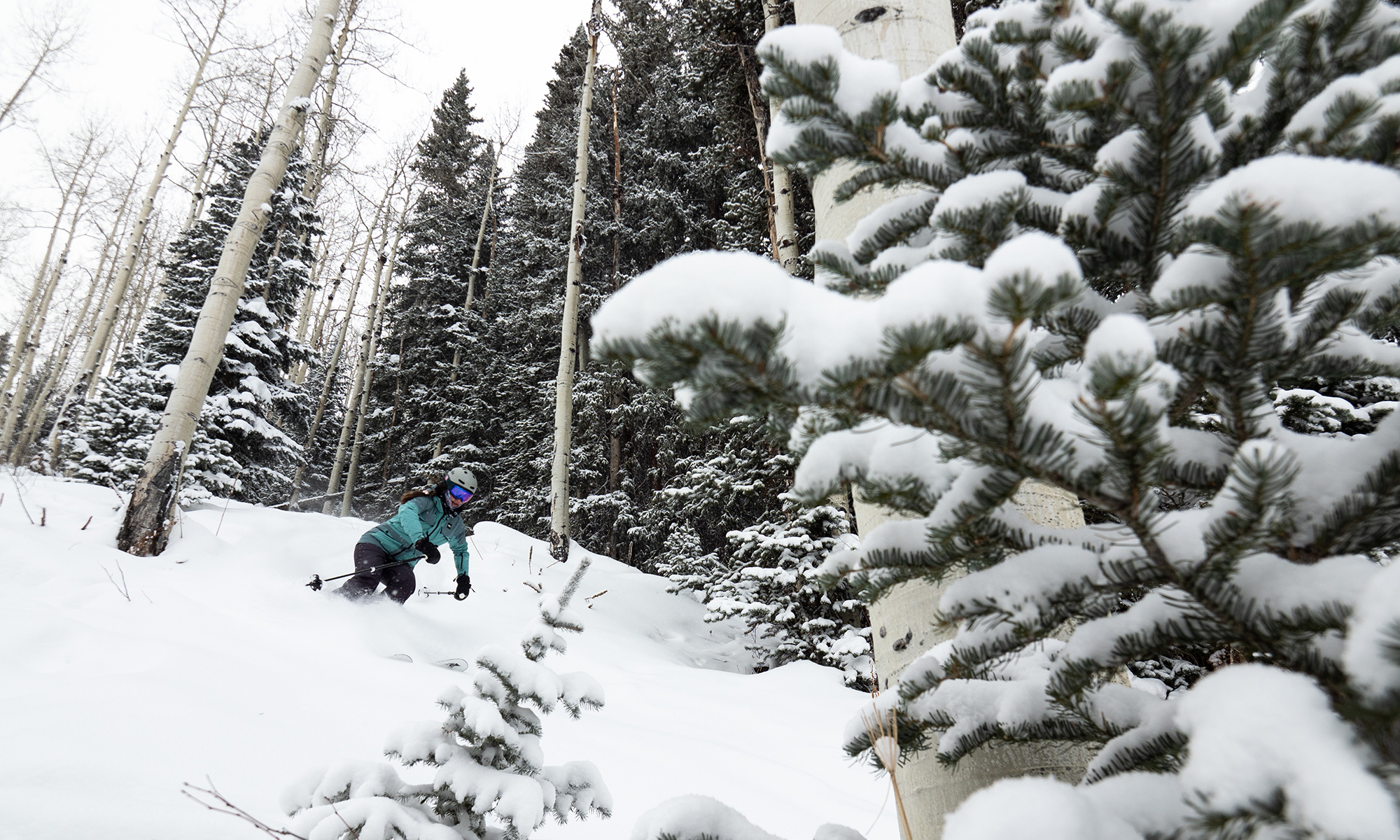
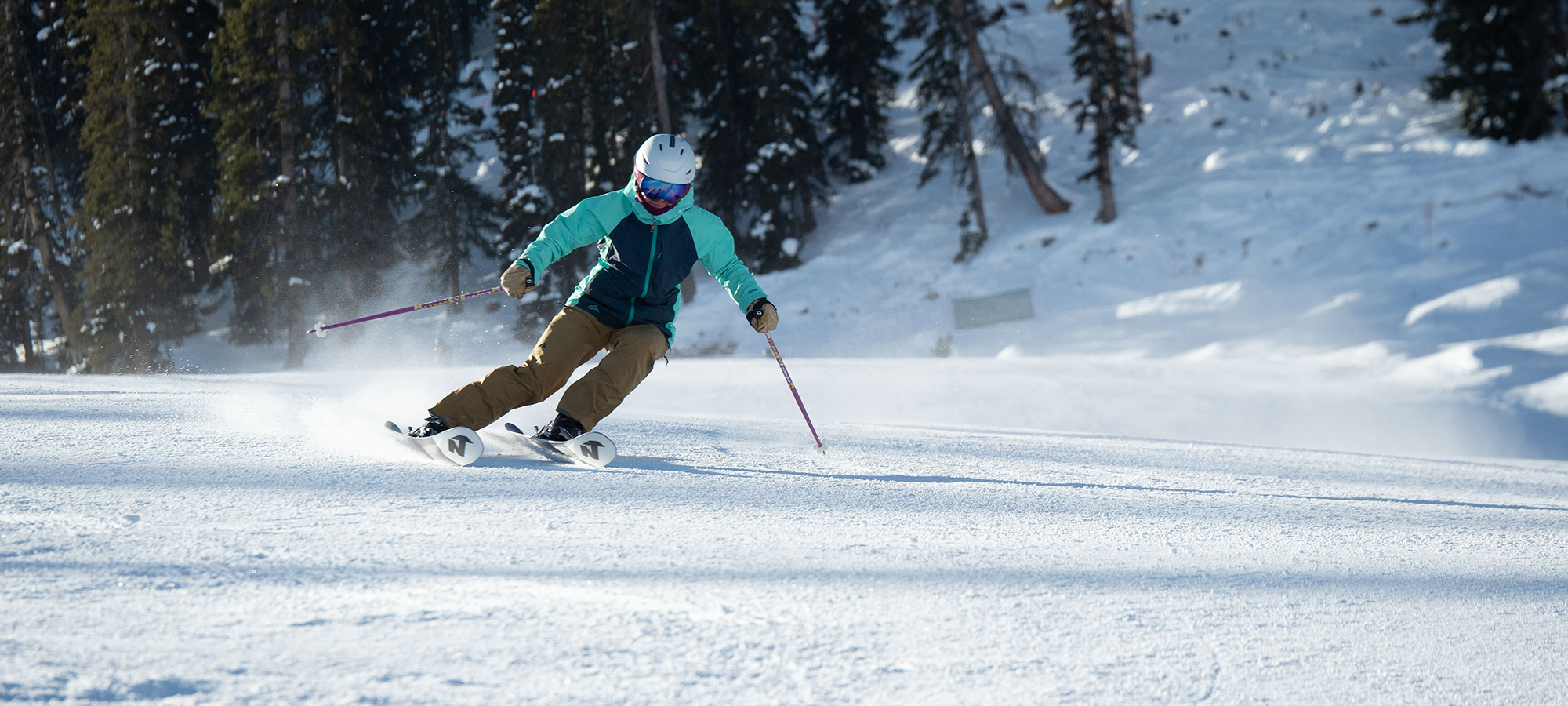
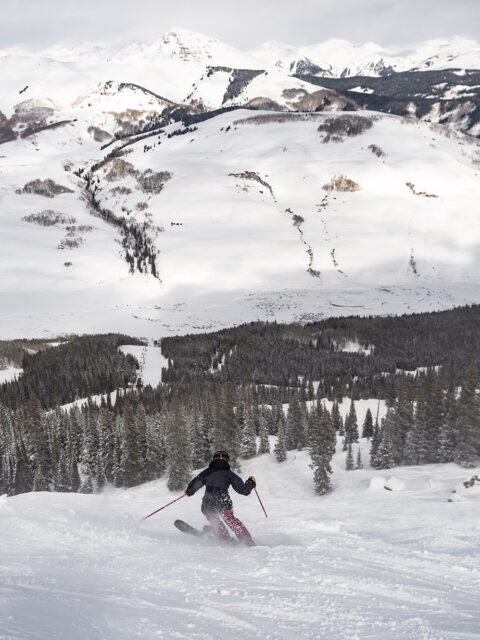
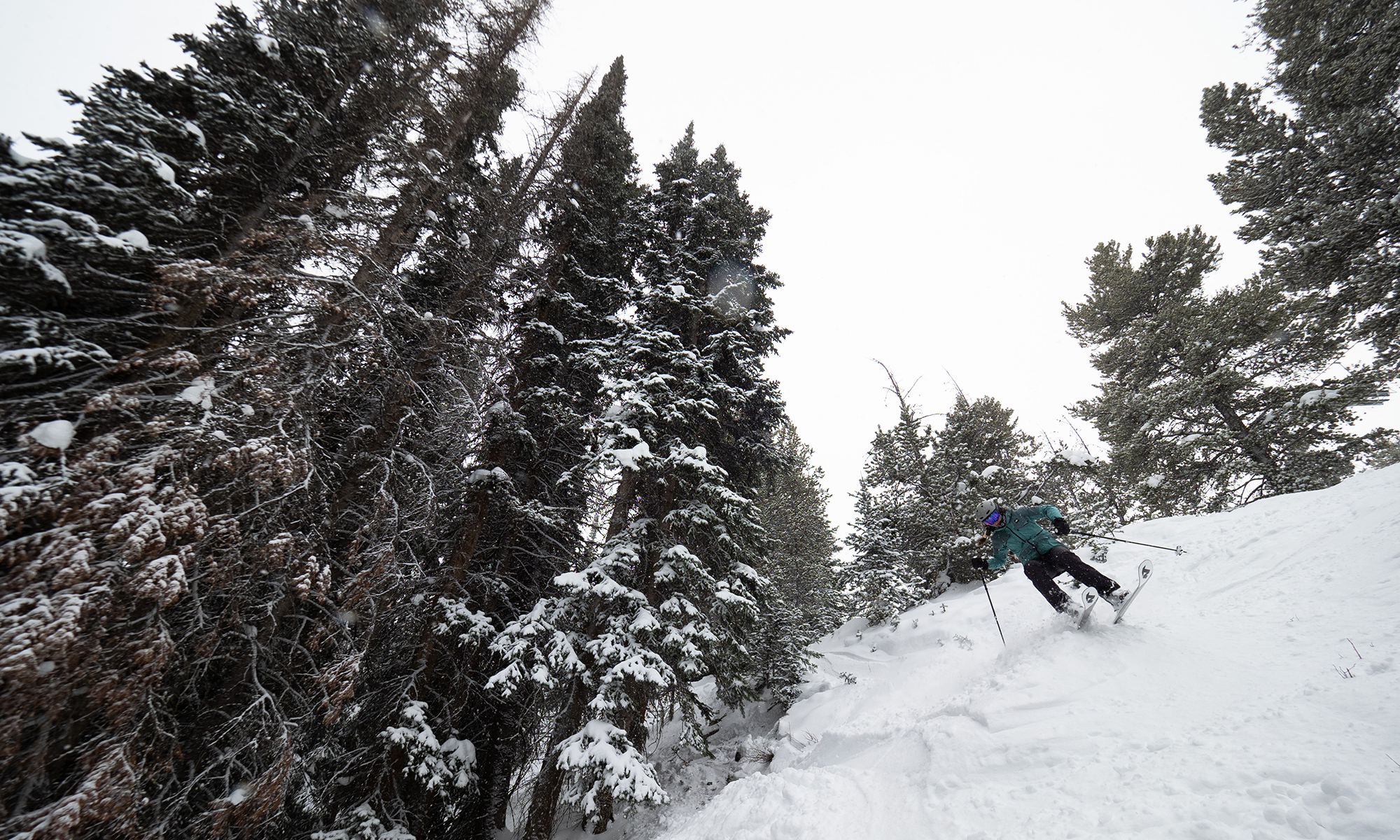
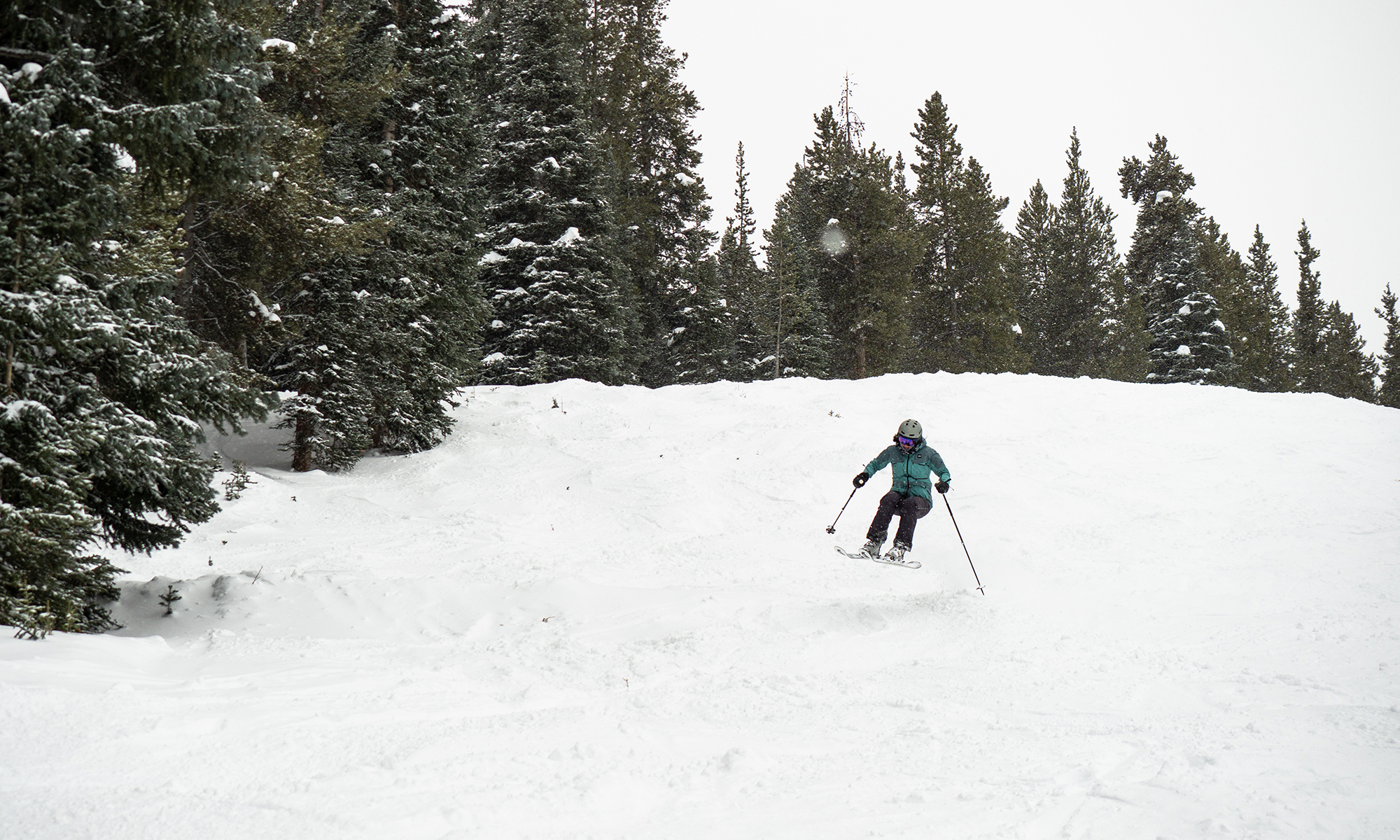
Would love to get on this ski to see what it’s like firsthand, but kind of bummed to hear it sounds like work. I think the La Nina is a GOAT ski and wish Nordica came back to make a ski more in that vein. I ski front range Colorado and so the more challenging terrain requires the ability to pivot and make quick turns (at least for me). Sheeva 10 has been great in that regard, just wish I went a little longer.
Agree! I would definitely recommend firsthand experience on this ski! It was a great ski and I loved skiing it although it was demanding. I am thinking the 165 cm maybe a bit easier for me to pivot and maneuver so hopefully I will be able to A/B at some point and report back in. That said, I do tend to prefer longer skis than what is typical for my height. Even at the 172 cm, this ski was a total blast to ski and even replaced the Line Pandora 104 for my one ski quiver this last fall. Would love to hear your thoughts on it!
That’s quite an endorsement then. I’d definitely go for the 158 or 165 as I’m a short person too
The tester is 5’1” (155 cm) and skiing a 172 length ski. I would think the 158 cm length would be a more appropriate choice. My impression of the ski based on this review is that it is too demanding… I suspect the review would have been very different if standard height-based ski selection were followed.
In my experince, when going down in ski length (i.e something under 165 cm), I have lost a fair amount of stability, making the overall ski feel very different and not as stable as I personally would like. So that said, I prefer to ski a length more in the upper 160 cm in length (and as we noted in the review, I did not have trouble with the 172 cm Rossignol Soul 7, which is similar in weight). The thing I enjoyed most about the Santa Ana 104 Free is it’s stability even though I had to ski it aggressively. The only place I really felt a shorter ski would have been advantageous was in the moguls or tight terrain-but so long as a shorter length wouldn’t give up stability. So I guess the question here is does one really just rely entirely on a standardized ski length chart based on height, or does skier preference and style play a larger role? As I mentioned in The Bottom Line, we are planning on adding additional perspectives form other reviewers so stay tuned to see what they say about this ski.
Pretty crazy you skied a ski 7 inches taller than you in fairly wide width. Not surprising at all it was not playful for you. Even the 158 would be taller than you. Of course with tail rocker they ski shorter but your light weight would make even the 165 more work. Hard to take a lot out of this since the skis were way too long no matter how good a skier you are. Would be nice to know what some of the other Blister gals think of this ski. Have been waiting a long time for a thorough review of this ski and its kind of disappointing. BTW I know you have to ski the length they send but it would have been nice to have the right length.
See above comment. As above, I am really excited to see what the other reviewers think and hope that can offer some more information for you so we can see how much length/width plays a role in how this ski performs.
Peter this comment is very unnecessary. The reviewer noted that the pair she was on was probably one size too big.
But who are you to recommend ski lengths for others as it’s up to personal preference and ability, neither of which you would be familiar with for this reviewer.
I am but a humble consumer of ski-related gear who spends his hard-earned money on a Blister membership in order to read reviews and make informed purchasing decisions. All reviews are subjective, but the more generalizable the results, the more useful the information to a potential consumer. I simply pointed out that the decision to review a ski two lengths above what an average consumer would ski makes the review less generalizable.
To Jon: most ski manufactures use height and skill levels to generate recommendations for ski length selection. I agree, who am I to recommend anything? Feel free to ski on whatever length you fancy, but the reviewer was on two lengths too big per Nordica’s recommendation (https://www.nordica.com/themes/Nordica19/downloads/nordica-adult-sizer.pdf).
Hey Sascha, how would you rate this against the K2 Mindbender 98ti? Commenting on behalf of my wife (Stacy) here. She’s 5’5″ 140lb. Currently riding the MB 98ti 161cm out here in the front range CO. She likes everything about the ski in terms of weight, flex, edgehold, powder performance, etc. But is finding that it’s letting her down in stability now that she’s charging harder down steeps (in particular East wall – A Basin and our most recent trip to Alta/Bird). I’m thinking the 168cm Mindbender would be much better for her than the 161cm that she has, but she’s also eyeing the 172 Santa Ana 104 Free. She doesn’t like a super stiff ski (but doesn’t want a noodle either – i.e. something like the Icelantic Maiden 101s she used to have). Her biggest worry would be that she’d have to be holding much more speed to get the 104 Free to “come alive”. However, given the 40 odd lbs and extra few inches she has over you, I think that might even it out a bit vs your experience with this ski? Thoughts?
Ski Length, Height, Weight, terrain and mount point:
I thought I would add some comments in regards to ski length selection in regards to height and weight of the athlete.
Certainly length selection is also a matter of personal preference of the type of performance an athlete desires out of the ski ,,,,, as well as skill set, skiing style used, muscle density and fitness and strength. These considerations are inconveniently complex but nevertheless require consideration when evaluating reviews and considering ones own selection.
For ski companies providing length recommendations based on height, it is obviously an over simplification of the selection process. The Blister Review process is one of the best I have seen at maintaining an authentic reporting process without inflicting bias.
However, I think it is important to maintain the perspective of the physical nature of the testers and the style of skiing they employ. For example, would a 5’ 7” 145 lb female with racing background that likes to charge faster lines find the Santa Ana 104 in 172 lacking in playfulness? Unlikely, and may much prefer the 179, and still find it light and playful, and the other skis mentioned lacking in stability.
Despite whatever the physical specifications are of the athlete, the mountain remains the same size in moguls ruts tree spacing chutes etc, and as such ski length that needs to span over the ruggedness of terrain can only go so short before it simply is giving away stability inflicted upon it by terrain, so despite height and weight of an athlete, going shorter in ski length is not always a solution for playfulness as at a certain point a shorter ski cannot span the variance in terrain shape and the ski is deflected by the terrain rather than directed by the skier.
Fortunately the ski industry has a plethora of product so whether you are a shorter powerful adult skier or an unusually tall light skier there are excellent products to be found that will provide excellent results to your unique physical form and desires, the trick of course is the selection for yourself abd the terrain and conditions you ski
Hi Sascha!
I’m on the hunt to find a better daily driver that suits my sweet spot. For reference I’m 5”7, 165 lbs and ski in the Pacific Northwest most days. My 100 underfoot daily driver is the Salomon Rocker2 100 178. I first got this ski used in spring last year and loved it because I mostly skied steeps and slushy groomers. The rocker2 is a Slush machine and I enjoy it so much in those conditions. It’s also the most stable ski I own and has gotten me comfortable asking high speeds.
This season that ski has really humbled me once I tried in soft snow and tight terrain. I have it mounted more center and I find that the amount of effective edge in the tail has punished me too many times, especially when I like to take more short and responsive turns. The ski demands to be driven very forward at all times, but in the soft snow I’m very fearful of nose diving. I’m a more than competent, aggressive skier, but the rocker2 shook a lot of my confidence out of me.
However, as soon as I switch to my softer daily driver (the armada zero stranger 172) I immediately wish I had a more stable ski when I’m off piste or in crud/shop (which is where I ski most). I’m just a sucker for this ski cause I like to have fun a play around as much as I like to bust through chop. I know the rocker2 100 is no longer made and I am not sure if you have had any experience on that ski or the rockette, but would you recommend the Santa Ana 104 free for a replacement? If so, based on my experience with the rocker2 100, would you recommend the 178 or 172? I’d love to flex these two skis side by side to see how they compare.
And to all the dudes here commenting about the ski size compared to the reviewer size, sit down and lower your voices. Engage in reviews that pertain to you instead of telling women (who probably know more than you) they don’t know how skis work. Ty!
Hi! Thanks for the review! I was wondering if you have any idea about performance of this ski for men? I’m 5’10, 155 lbs. I’ve tried Enforcer 104 free and overall liked it. However, would prefer something more playful and lighter. Fischer Ranger 102 fr sounds like perfect fit to me but I cannot get it where I live. Thanks for your time!
Hi! Your review validated my demo experience on the 104s – I definitely felt like I had to be fully present and when I was they gave me so much energy. The 98s in comparison didn’t need as much work to get the same feedback (but less playful and felt super stable overall). I ended up getting the 104s (I’m 5’4, got the 165cm) to complement my BP 88s (2016) which are much lighter and nimble.
I do think the weight information presented might be incorrect – Nordica says the 98s are lighter than the 104s – unless they’re sharing misleading info. The 104s are likely lighter than past years’ 100s with more metal. This is what Nordica stated (although not sure what length this is for)
SA 104: 4.25 KG per pair without bindings
SA 98: 3.68 KG per pair without bindings.
Great review Sascha! One of our daugthers is similar height as you and we had been wondering about this ski, so it’s good to get your take on it. She is not skiing at your level so would definitely go 165.
Great review!! Hate to be the typo police, but you’ve got Kara Williard’s weight listed as 75 g in multiple places… making her the world’s lightest adult human at 0.165 lbs.
First of all to you who think Sascha skied to long skis for her size, you can just read Karas review.
@Sascha I am thinking of buying this to my daughter soon 18 years old 158cm/52kg, pretty strong legs (figure skater) skied since she was 3 years old and pretty advanced skier
She skis völkl Kanjo now in 154cm, skis quite fast and pretty straight lines. But she likes going off pist and in tight terrain/trees (Moste skiing in Scandinavia)
Latest seasons she most did snowboarding though (freeride/allmountain)
From your experience and your weight and level on the 172cm ski length, would you recomend158cm or 165cm for the her?
Or would you say the Sheeva 10 would be a better choice maybe?
I am a man, around 76 kg. I have no clue about skis. Can I ride these skis or is there a big difference the way they behave? Too soft or what else should I consider? I can get them for a good price that is why I ask. Thank you and sorry for a dumb question :)
Hi, thanks so much for the thoughtful review. I’m wondering if either of you have skied the Nordica La Niña (predecessor to the Santa Ana)? I’m looking for a replacement for those skis which I absolutely love. I would like a ski with a narrower 100-105 mm waist and am considering either the Nordica 104 Free or the Blizzard Sheeva 10. Your thoughts are greatly appreciated. Thanks!